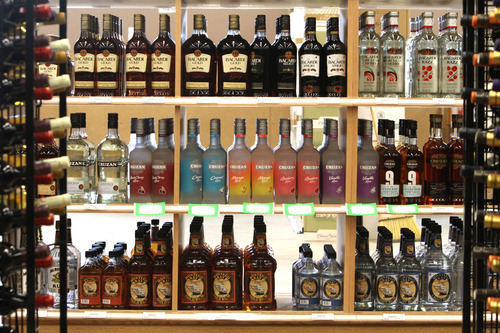This is an archived article that was published on sltrib.com in 2013, and information in the article may be outdated. It is provided only for personal research purposes and may not be reprinted.
To keep up with liquor sales and a growing population, Utah needs to build 12 more liquor stores along the Wasatch Front, a new study from the University of Utah recommends.
"There are a number of locations across the Wasatch Front that we feel are underrepresented," according to the report, which was conducted by professional MBA students at the U.'s David Eccles School of Business at the request of the Utah Department of Alcoholic Beverage Control (UDABC).
To determine demand, students used a Utah legislative formula that calls for one liquor store for every 48,000 citizens. The state has 44 stores, but Utah needs to have 55.6 stores based on its current population of 2.8 million and a 1.47 percent annual growth rate, the study states.
The last new liquor store to open in Utah was in 2010 in Springville.
The group also looked at average yearly sales figures to determine areas in most need.
"The results of this data showed first that we needed to focus our efforts on the Wasatch Front, as more rural areas had very little need and were serviced by package agencies or retail licenses," the report states.
The greatest need for liquor stores is in parts of central Davis County, southern Salt Lake County and Utah County. One new store in each of the following areas is recommended:
• Syracuse, Clearfield and Layton
• Farmington, Fruit Heights and Kaysville
• West Valley, South Salt Lake
• Taylorsville, West Valley
• Kearns
• West Jordan
• Herriman
• South Jordan
• Draper/Sandy
• Lehi, Eagle Mountain
• Highland, American Fork, Alpine and Saratoga Springs
• Spanish Fork, Payson and Springville
The U. business students will make a formal presentation to the state liquor commission at its next meeting on Tuesday, Jan. 28.
UDABC Executive Director Sal Petilos said several years ago the legislative auditor general recommended that the UDABC create a strategic plan for expanding its network.
The study "is the first step in that process," he said, noting that before any new stores are built, the UDABC must get approval from the state building board and funding from the legislature. The DABC also must get approval from the cities affected.
"Local consent is a huge deal and it's part of the statute," said Petilos.
Melissa Johnson, mayor of West Jordan, wasn't surprised to find her city on the list.
"I've had people complain to me that we don't have a liquor store," she said in a telephone interview. "We are 32 square miles and have 108,000 residents and we don't have a liquor store."
Johnson, however, was not sure that residents, many of whom abstain from alcohol as members of the Mormon church, would be supportive of a liquor store.
"There would be a segment of the community that would be opposed," she said. Her comment is based on experience. A few years ago the city council discussed selling beer at the rodeo arena and there was "a lot of public outcry," she said.
Mike Winder, the out-going mayor of West Valley City, didn't seem as concerned.
"If the analysis shows there is a void then it's obviously something we should take a look at," he said. "We certainly are growing and our city is becoming increasingly diverse with people from various backgrounds."
Twitter @kathystephenson Coming to a town near you?
A study conducted by U. MBA students says the greatest need for liquor stores is in central Davis County, southern Salt Lake County and Utah County. It recommends a new store in each of these areas:
Syracuse, Clearfield, Layton
Farmington, Fruit Heights, Kaysville
West Valley City, South Salt Lake
Taylorsville, West Valley City
Kearns
West Jordan
Herriman
South Jordan
Draper, Sandy
Lehi, Eagle Mountain
Highland, American Fork, Alpine, Saratoga Springs
Spanish Fork, Payson, Springville



